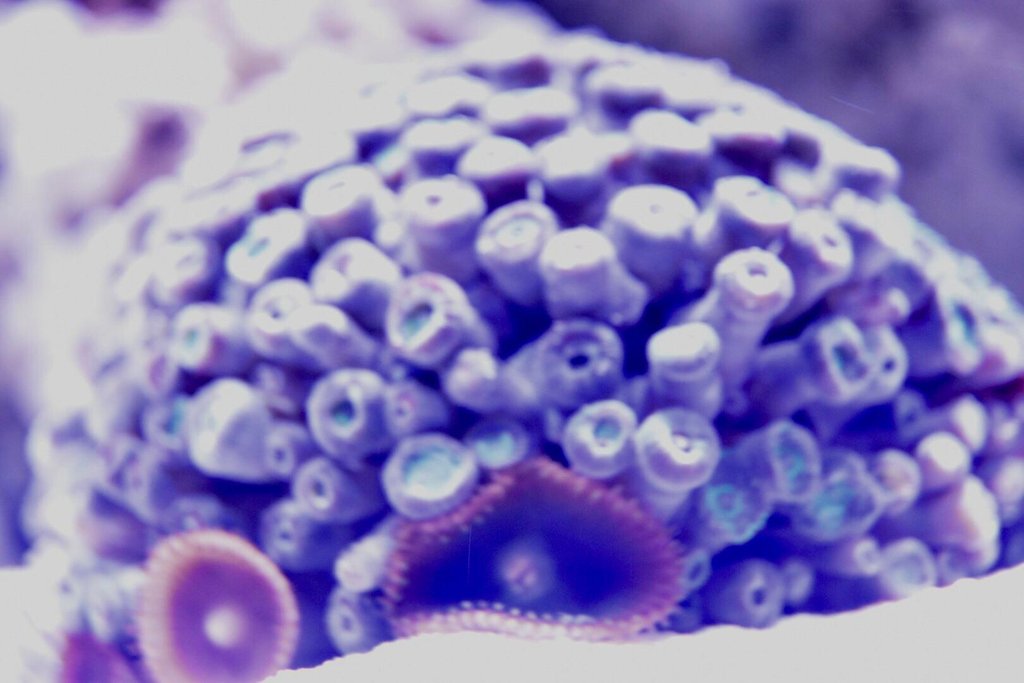First, a little background on my tank. I have a 35-gallon hex that has recently been set up as a Bermuda biotope tank. I live in Bermuda, and the reef keeping hobby is off-limits because the importation of anything that will survive in salt water is strictly prohibited and almost all local corals are protected. That means that if I want to do a saltwater tank, I have to limit my inhabitants to things that I collect myself (well, with my kids) from local waters and they must not be on the protected species list.
The tank has dried rock (curing in the sun for, oh close to 160 years) and live sand and I have (or had) a pair of juvenile beaugregory damsels and a pair of sergeant major damsels living happily in the tank while it cycled. On the weekend, I collected two clusters of zooanthids and placed them in the tank. I suspect they are palythoa mammillosa (a.k.a moon polyps, sea mat, button polyps) and zoanthus socialus, (a.k.a green carpet, green sea mat) but I really have no idea and that was the best I could do with the information I had to work with. The zoanthus socialus is wound pretty tight and hasn't opened up yet, still annoyed by the move. The palythoa mammillosa (I think) is much more relaxed and has opened up.
Last night, while observing my fish, I watched the larger beaugregory damsel take a run at the smaller beaugregory damsel (they are still jockeying for position and dominance). While the smaller one was darting from the larger one, he came into contact with the polyp shown in the photo at the bottom of this group, which I assume is a palythoa mammillosa. He went into shock immediately, appearing paralyzed. A few seconds later he began moving again and limped off to hide in a hidey-hole where the larger fellow couldn't bother him. I gathered him up and put him in segregation in the tank, but he was dead within a few minutes.
Being my first go at a saltwater tank, I am wondering if zoanthids/palythoas killing fish by stinging is a common concern, if they usually just learn to avoid each other, or is this polyp in the bottom of the photo something I should remove from the tank while there are only one or two polys? Does anyone have a better ID?
The tank has dried rock (curing in the sun for, oh close to 160 years) and live sand and I have (or had) a pair of juvenile beaugregory damsels and a pair of sergeant major damsels living happily in the tank while it cycled. On the weekend, I collected two clusters of zooanthids and placed them in the tank. I suspect they are palythoa mammillosa (a.k.a moon polyps, sea mat, button polyps) and zoanthus socialus, (a.k.a green carpet, green sea mat) but I really have no idea and that was the best I could do with the information I had to work with. The zoanthus socialus is wound pretty tight and hasn't opened up yet, still annoyed by the move. The palythoa mammillosa (I think) is much more relaxed and has opened up.
Last night, while observing my fish, I watched the larger beaugregory damsel take a run at the smaller beaugregory damsel (they are still jockeying for position and dominance). While the smaller one was darting from the larger one, he came into contact with the polyp shown in the photo at the bottom of this group, which I assume is a palythoa mammillosa. He went into shock immediately, appearing paralyzed. A few seconds later he began moving again and limped off to hide in a hidey-hole where the larger fellow couldn't bother him. I gathered him up and put him in segregation in the tank, but he was dead within a few minutes.
Being my first go at a saltwater tank, I am wondering if zoanthids/palythoas killing fish by stinging is a common concern, if they usually just learn to avoid each other, or is this polyp in the bottom of the photo something I should remove from the tank while there are only one or two polys? Does anyone have a better ID?




















